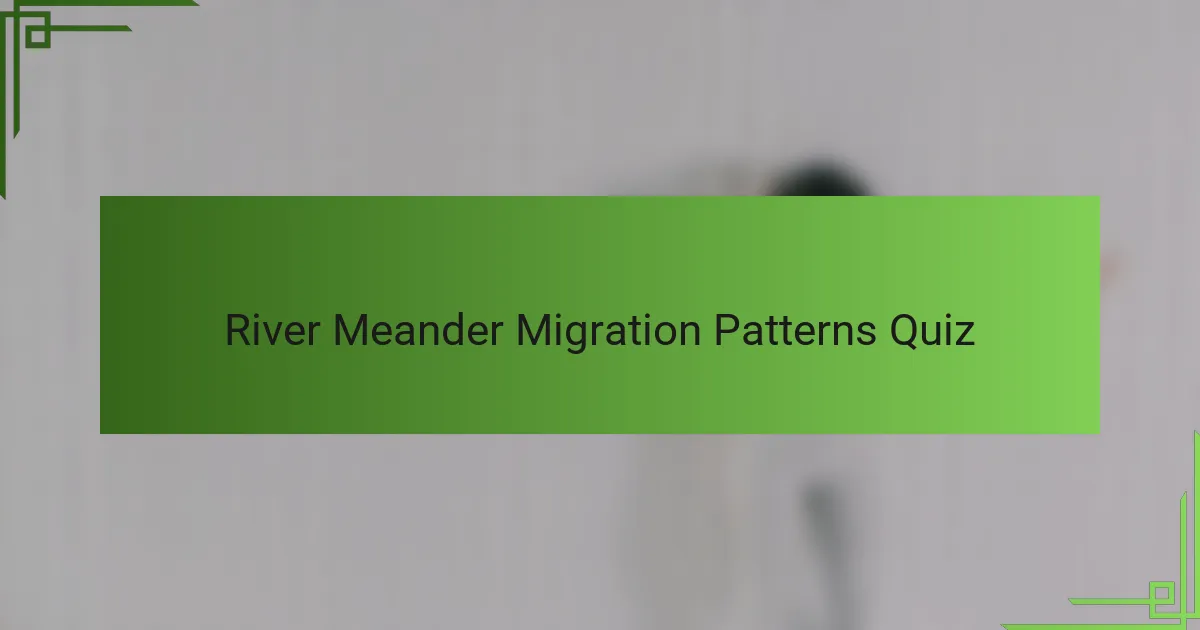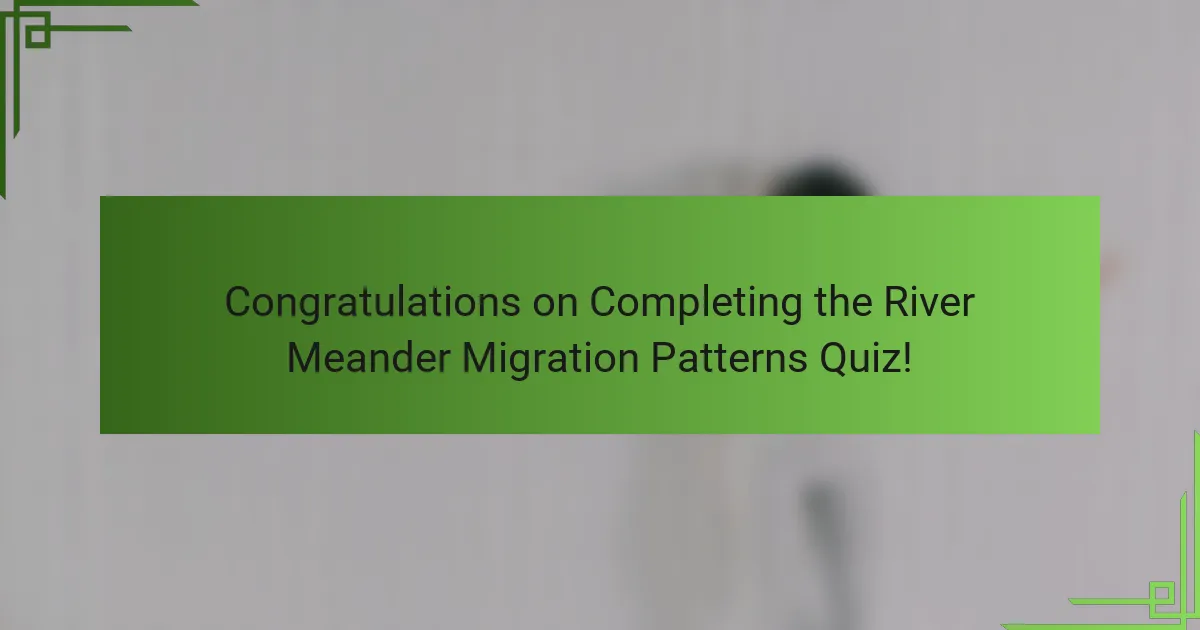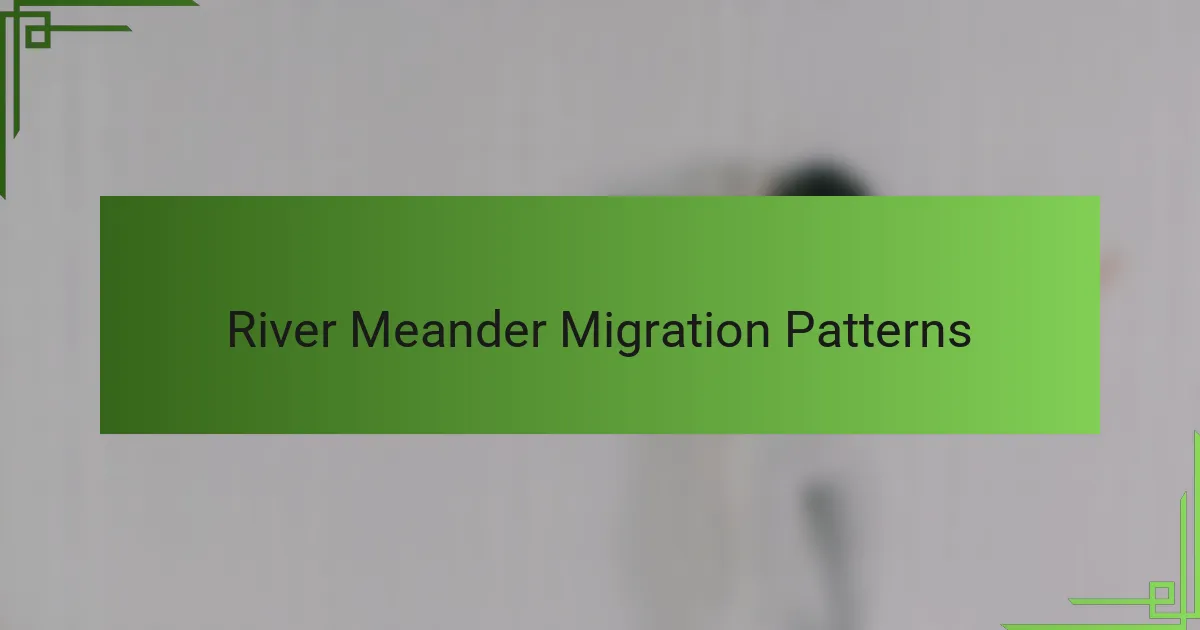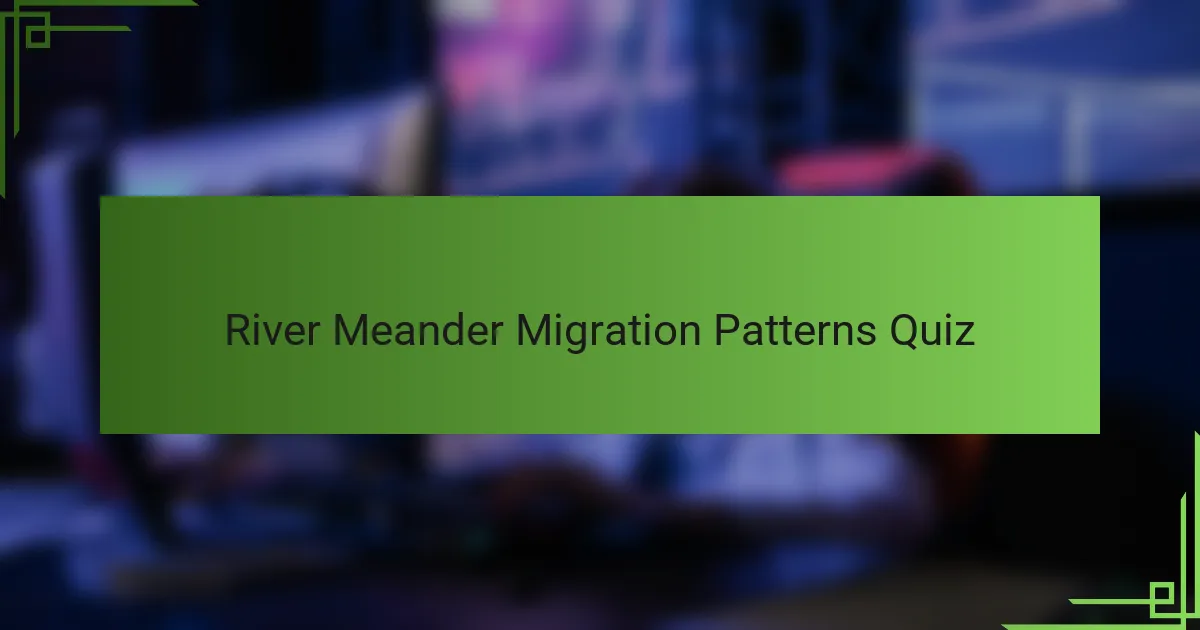
River Meander Migration Patterns Quiz
1. What term describes the shifting movement of a river’s meander bend over time, commonly studied in the Mississippi River?
- Oxbow lake formation
- Floodplain aggradation
- Meander migration
- River avulsion
2. Which river in the United Kingdom is famous for its pronounced meander migration patterns visible from aerial photography?
- River Wye
- River Trent
- River Thames
- River Severn
3. The process of river meander migration significantly influenced the landscape around the Mississippi River Delta in which U.S. state?
- Arkansas
- Texas
- Louisiana
- Mississippi
4. What scale is typically used to measure the rate of meander migration in a river such as the Brahmaputra River?
- Millimeters per month (mm/month)
- Meters per century (m/century)
- Centimeters per year (cm/yr)
- Kilometers per decade (km/decade)
5. Which African river’s meander migration has been studied extensively due to its impact on local ecosystems and settlements?
- Zambezi River
- Orange River
- Congo River
- Niger River
6. What geological feature often forms from abandoned meanders caused by river meander migration, named after the Rhine River?
- Rhine alluvial fan
- Rhine delta
- Rhine oxbow lake
- Rhine estuary
7. The Amazon River exhibits dynamic meander migration; what effect does this have on the surrounding floodplains of Brazil?
- It results in the formation of steep riverbanks, reducing the area available for seasonal flooding.
- It creates extensive oxbow lakes and fertile floodplains that support dense vegetation and diverse wildlife.
- It increases sediment deposition at the river mouth, causing the Amazon Delta to expand significantly.
- It causes permanent widening of the river, leading to large-scale urban flooding in nearby cities.
8. In the context of river meander migration, what significant event occurred along the Colorado River leading to changes in its channel path?
- Significant tectonic uplift redirected the river to a new drainage basin.
- The Colorado River experienced a major avulsion event altering its channel path.
- The river underwent extensive sediment deposition causing gradual channel widening.
- A glacier dammed the river, creating a temporary lake and diverting the flow.
9. Which European river’s meander migration is closely monitored due to its impact on agricultural land along the Danube River basin?
- The Po River
- The Tisza River
- The Vistula River
- The Elbe River
10. Meander migration patterns on the Ganges River have been linked to increased erosion in which country?
- Bhutan
- Nepal
- India
- Bangladesh
11. In the context of meander migration, what is an oxbow lake, and which river system is famous for their abundance?
- An oxbow lake is a crescent-shaped lake formed when a meander from a river is cut off, and the Mississippi River is famous for its abundance of oxbow lakes.
- An oxbow lake is a delta lake formed from sediment deposits, with the Amazon River being famous for them.
- An oxbow lake forms from tectonic uplift creating isolated basins, notably in the Colorado River Basin.
- An oxbow lake is a seasonal lake created by monsoon floods, commonly found in the Ganges River system.
12. Which river in New Zealand exhibits rapid meander migration, affecting both its ecology and local human infrastructure?
- Waimakariri River
- Rakaia River
- Ashley River
- Clutha River
13. How does sediment load influence the rate of meander migration in the Yangtze River?
- Sediment load decreases meander migration by stabilizing the riverbanks and reducing lateral erosion.
- Sediment load has no significant effect on meander migration rates but influences only channel depth.
- Higher sediment loads increase meander migration rates by enhancing bank erosion and sediment deposition patterns in the Yangtze River.
- Increased sediment load slows meander migration by promoting vertical riverbed aggradation and reducing lateral shifts.
14. The Volga River’s meander migration has played a role in shaping settlement patterns in which Russian region?
- The Volgograd Oblast
- Krasnodar Krai
- Tver Oblast
- Moscow Oblast
15. What technological method is commonly used to monitor meander migration on rivers such as the Mekong?
- Ground-penetrating radar
- Satellite remote sensing
- Sonar mapping
- Aerial photogrammetry

Congratulations on Completing the River Meander Migration Patterns Quiz!
You’ve just explored the fascinating world of river meander migration through this quiz. This topic is essential in geography because it explains how rivers shape landscapes over time. Understanding these patterns helps us grasp how water flow affects erosion, sediment deposition, and changes in river paths.
By working through the questions, you likely learned about the processes that cause meanders to move, such as erosion on the outer banks and deposition on the inner banks. You also discovered why meander migration is important for ecosystems and human activities. These insights provide a clearer picture of the dynamic nature of rivers and their impact on the environment.
If you’re eager to deepen your knowledge, we invite you to explore the next section on this page. It offers detailed explanations and examples on river meander migration patterns. Diving further into this topic can enhance your understanding of geographical processes and how they shape the world around us.

River Meander Migration Patterns
Understanding River Meander Migration Patterns in Fluvial Geography
River meander migration patterns refer to the natural movement and evolution of river bends over time within a fluvial system. In geography, meanders are sinuous curves or bends in a river channel, commonly observed in low-gradient, alluvial plains. These patterns result from the dynamic processes of erosion and deposition. Erosion occurs on the outer bank of a meander where water velocity is higher, while deposition happens on the inner bank where velocity slows down, causing sediment buildup. This continuous process causes the river channel to shift laterally, creating a migration of the meander. The Mississippi River in the United States is a prime example exhibiting significant meander migration, shaping its floodplain landscape over centuries.
Hydrodynamic Forces Driving Meander Channel Migration
The primary forces influencing river meander migration patterns stem from hydrodynamics, including flow velocity, shear stress, and secondary currents. Helical flow, a corkscrew-like motion in the river bend, transports sediment from the outer bank to the inner bank, facilitating lateral migration. Shear stress exerted by flowing water on the bank determines erosion rates, particularly on the concave bank. These forces interact with the riverbed’s sediment composition and bank material strength. Studies from the Thames River in England show how variations in flow velocity during seasonal discharge affect the migration rates and direction of meanders.
The Role of Bank Erosion and Sediment Deposition in Meander Movement
Bank erosion and sediment deposition are critical mechanisms in the migration of river meanders. Erosion on the outer bank occurs due to the concentration of flow velocity and turbulence, leading to undercutting and mass wasting of bank materials. Conversely, the inner bank experiences sediment deposition where velocity decreases, leading to point bar formation. This asymmetrical process drives lateral channel shift. Research on the Amazon River demonstrates that fine sediment availability and cohesive bank materials significantly influence erosion rates, thereby affecting meander migration speed and pattern.
Impact of River Meander Migration on Floodplain Morphology
River meander migration directly shapes floodplain morphology by altering channel position and creating features such as oxbow lakes, levees, and natural levees. As meanders migrate, they erode one bank while depositing sediment on the opposite side, gradually expanding the floodplain laterally. Over time, abandoned meanders form oxbow lakes, which are crescent-shaped water bodies separated from the active channel. The Ganges-Brahmaputra Delta region exhibits extensive meander migration with resultant complex floodplain landscapes, influencing agriculture, ecosystem distribution, and human settlement patterns.
Monitoring and Modeling Meander Migration Using Geographic Technologies
Geographic Information Systems (GIS), remote sensing, and hydraulic modeling are extensively used to monitor and predict river meander migration patterns. Satellite imagery and aerial photography provide temporal data to track channel shifts and validate models. Numerical hydrodynamic models simulate flow behavior and sediment transport to estimate future meander positions. For example, studies on the Danube River utilize GIS-integrated hydraulic models to forecast meander evolution, assisting in flood risk management and river engineering projects. These technologies enable precise and cost-effective monitoring essential for managing riparian environments.
What are river meander migration patterns?
River meander migration patterns refer to the natural process where the bends or curves of a river channel shift laterally over time. This occurs as erosion happens on the outer banks and deposition on the inner banks of meanders, causing the river to gradually change its course. This process is driven by the flow velocity and sediment load within the river, which reshape its channel over years or decades. Studies of rivers like the Mississippi River show clear evidence of meander migration through historical maps and satellite imagery, demonstrating how meanders can shift several meters to kilometers over time.
How do river meanders migrate?
River meanders migrate through the combined action of erosion and deposition. Water flows faster on the outer curve of a bend, eroding the bank, while slower flow on the inner curve deposits sediment. This causes the meander to shift laterally downstream. The process involves hydraulic forces and sediment transport, where fine sediments eroded upstream are deposited downstream. Scientific measurements of riverbanks and sediment layers confirm this mechanism across various meandering rivers worldwide.
Where do river meanders typically migrate?
River meanders typically migrate within the floodplain area adjacent to the river channel. This migration usually occurs along the middle and lower courses of a river, where the gradient is gentle and the river carries a high sediment load. Examples include the floodplains of the Amazon River and the Mississippi River delta, where meanders shift over wide flat areas, altering the river’s position but remaining within the broader floodplain zone.
When does river meander migration happen?
River meander migration occurs continuously but is more pronounced during periods of high flow or flood events when the river’s energy and sediment transport capacity increase. Seasonal changes, such as snowmelt or monsoon rains, amplify the processes of erosion and deposition. Long-term studies of rivers like the Colorado River indicate measurable meander migration over decades, confirming that this is a gradual and ongoing process influenced by flow variability.
Who studies river meander migration patterns?
River meander migration patterns are studied primarily by geomorphologists, hydrologists, and environmental scientists. These experts analyze river dynamics using field measurements, remote sensing technologies, and computer modeling. Institutions such as the United States Geological Survey (USGS) and research universities conduct detailed investigations of meander migration to understand river behavior and manage flood risks. Their work provides validated data on sediment transport and channel changes essential for environmental and engineering applications.
